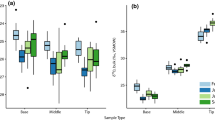Abstract
A recently described phloem-bleeding technique was used to study seasonal changes in δ13C, sugar levels and the amino acid:sugar balance of phloem translocate of 2- to 3-year old trees of Eucalyptus globulus at a rain-fed site (Eulup) and a waste-effluent-irrigated site (Albany) in south-west Australia. δ13C of phloem sap from the Eulup site fluctuated widely between winter (−27.6‰) and peak summer stress (−20.2‰), compared with a much smaller range of −28.4 to −26.3 at Albany. Seasonal changes in sugar concentrations in sap fluctuated closely with those of phloem δ13C, with highest concentrations and least negative δ13C values at times of greatest soil water deficit. Molar ratios of amino acids to sugars in phloem sap were similar between plantations in winter through to early summer. They then remained high at the nitrogen-rich effluent-treated site, but fell dramatically once soils dried out at Eulup. Mature leaf dry matter sampled at peak yearly stress (early autumn) showed more negative δ13C values than concurrently harvested phloem sap or recently initiated shoot apex dry matter, presumably because the sampled foliage had laid down its structural carbon earlier under relatively unstressed winter/spring conditions. Differences between Albany and Eulup were much greater for δ13C of phloem and new apical dry matter than for dry matter of mature foliage. Comparisons of δ13C signatures of phloem sap carbon with those of dry matter of nascent xylem tissues showed seasonal fluctuations in δ13C of phloem translocate which were mirrored a month or so later by those for xylem carbon. δ13C analyses of trunk growth rings from Eulup and Albany showed well-defined seasonal oscillations over the first 2 or 3 years of growth until irrigation commenced at Albany. Fluctuations in δ13C at the latter site then became noticeably less pronounced than at Eulup. Future use of phloem sap δ13C and solute analyses for studying seasonal water and nutrient status of E. globulus is discussed.
Similar content being viewed by others
Author information
Authors and Affiliations
Additional information
Received: 9 April 1998 / Accepted: 20 August 1998
Rights and permissions
About this article
Cite this article
Pate, J., Arthur, D. δ13C analysis of phloem sap carbon: novel means of evaluating seasonal water stress and interpreting carbon isotope signatures of foliage and trunk wood of Eucalyptus globulus . Oecologia 117, 301–311 (1998). https://doi.org/10.1007/s004420050663
Issue Date:
DOI: https://doi.org/10.1007/s004420050663




